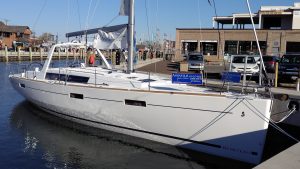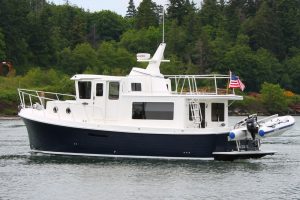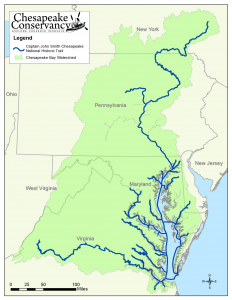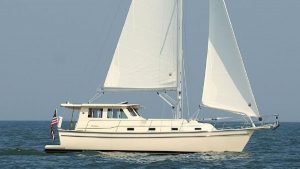Sailboat or Trawler?

Cruiser’s University is a boating education program for sailors and power boaters held at the US Naval Academy twice a year during the Annapolis Spring and Fall Sailboat Shows. This past Thursday, April 19th through Sunday, April 22nd, I spent four days attending four 90 minutes classes each day, selected from over 50 classes taught by very knowledgeable, experienced sailors.
America’s Great Loop? What?
Two years ago, I met a physician at a cocktail party and we started discussing boats. He told me of his adventure, boating more than 5,600 miles through 20 some states making a great counter-clockwise loop on America’s waterways. This was the first time I had heard about the Loop, an adventure he completed the previous year. Thus I was very intrigued to learn more from the presentation of Kim Russo, Director of America’s Great Loop Cruisers’ Association (AGLCA).

The Loop starts and ends wherever you have your boat … No U-turns! Typically cruisers start in Florida in the early Spring moving northward on the ICW (Intracoastal Waterway) into the Chesapeake Bay, on to New York City, up the Hudson River and spending the summer and Fall on the Great Lakes. Then down the Illinois River from Chicago, into the Mississippi River to St. Louis, over to the Ohio and Tennessee Rivers down to Mobile Alabama. From there across the Gulf to Florida and down to the Keys or the Bahamas for the winter. The route is flexible with many side trip opportunities and about 100 boats or so complete this trip every year. Many complete the trip over multiple years.
Why counter-clockwise? Because of the river flow. Too hard and too much fuel to go up the Mississippi.
Why the Ohio and Tennessee Rivers? The lower Mississippi has too much commercial traffic.
Billed as a high adventure, low-risk endeavor, the required boating skill set is moderate, you are seldom in danger, and is best considered a series of one-day cruises (typically 50 miles) to interesting locations. Spend time visiting the towns along the way. While smaller trawlers (full displacement, single-engine, fuel efficient, slow speed power boats) are popular, now people do the Loop in bigger, faster boats, sailboats, and even small boats. Anything goes.
So what are the biggest costs? Apparently, marina fees are at the top of the list. Fuel comes second though it really depends on how you cruise. A slow efficient trawler might use $5,000 worth of diesel while a fast powerboat might use $30,000 worth of fuel.
Hmmm, I began Cruiser’s University with the intention of learning as much about sailing as possible and now I spend time thinking about a 34′ trawler instead. Sure would be easier, more comfortable, and less physically demanding than sailing.

Looks like an awesome thing to do. Click on the map to see Captain John’s website or click here for America’s Great Loop Cruiser’s Association.
Anybody interested in going?
The Chesapeake in 7 Days

John Stefancik, the publisher of Chesapeake Bay Magazine, gave us a talk on cruising the Chesapeake Bay, one of the best cruising grounds in the world with a mix of urban, suburban, and rural sailing. I came away with a strong desire to “gunkhole” the Chesapeake Bay for a few months (or years!) Gunkholing is an interesting boating term that refers to cruising in shallow (shoal) waters, meandering from place to place, discovering rivers, creeks, and coves. No fixed agenda, just explore. Maybe follow the John Smith National Historic Trail. Sounds like a great retirement activity!
Hmmm … could do that with the trawler or a sailboat. Getting harder to focus on one activity….
Social
There are many nice people involved in boating (as with RVing, motorcycle touring, etc). Hats off to Fred and Randy from Texas and Cindy and Mark from St. Louis for pleasant conversation and friendship. Socialization during the meals was a highlight of the CU and I hope I run into them again.
Few Boating Tips
- A new boat means NEW, Not Everything Works. Go over a new boat with a fine-toothed comb because there are always problems with the boat. Survey a new boat in and out of the water after delivery. Leave nothing to chance.
- If you want to sell your house and live on a boat follow this order: stay in your house, buy the boat, then sell the house. The bank will never give you the loan if you tell them you are going to liveaboard.
- Similarly, keep your job, get the loan, then retire. I made this mistake. It is much harder to get a loan if you don’t have a job.
- Use a Buyer’s Broker to help you find and buy the boat. The process is complicated enough that you will benefit from an expert who has your interest in mind.
Other Stuff
Other classes I attended were in Crisis Management, sail trim, heavy weather sailing, maintenance, single-handed sailing, navigation, and boat buying. The presenters were top notch and I would attend again to listen to the topics I missed such as the diesel engine course. I have lots more esoteric sailing and maintenance notes to share but
I keep thinking “trawler or sailboat, trawler or sailboat”?
How about a hybrid? The Island Packet SP Cruiser!!!!!
